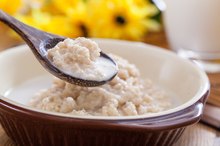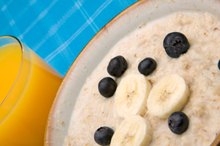What does fact checked mean?
At Healthfully, we strive to deliver objective content that is accurate and up-to-date. Our team periodically reviews articles in order to ensure content quality. The sources cited below consist of evidence from peer-reviewed journals, prominent medical organizations, academic associations, and government data.
- Mayo Clinic: Whole Grains: Hearty Options for a Healthy Diet
- Mayo Clinic: Healthy Breakfast: Quick, Flexible Options to Grab at Home
The information contained on this site is for informational purposes only, and should not be used as a substitute for the advice of a professional health care provider. Please check with the appropriate physician regarding health questions and concerns. Although we strive to deliver accurate and up-to-date information, no guarantee to that effect is made.
What Is Fortified Oatmeal?
Refined grains are “enriched” when manufacturers add certain vitamins and minerals, and the term for whole grains with extra vitamins and minerals is “fortified,” according to the 2010 Dietary Guidelines from the U.S. Department of Health and Human Services 1. To qualify as fortified, whole grains, including oatmeal, must have specific nutrients in them. Oatmeal can be a nutritious food for breakfast or as a snack later in the day.
Oatmeal Nutrition
It has less than 2 g total fat, including less than 0.5 g saturated fat, which raises unhealthy LDL cholesterol levels in your blood. Oatmeal has 19 g total carbohydrates and nearly 3 g dietary fiber, or 12 percent of the daily value. Oats have no cholesterol. These values are nearly identical to the values in non-fortified oatmeal.
- It has less than 2 g total fat, including less than 0.5 g saturated fat, which raises unhealthy LDL cholesterol levels in your blood.
- Oatmeal has 19 g total carbohydrates and nearly 3 g dietary fiber, or 12 percent of the daily value.
Vitamins and Minerals
Does Oatmeal Always Have Folic Acid?
Learn More
The amounts of these B vitamins are much higher than in non-fortified oatmeal. Fortified oatmeal is also high in folic acid, vitamin A and iron, compared to non-fortified oats. Micronutrient-fortified oatmeal has 99 mg calcium, compared to 14 mg in regular oatmeal.
Oatmeal and Whole Grains
Oatmeal is a whole grain, which means that it contains the bran, germ and endosperm components of the entire grain kernel. Other examples of whole grains are whole-wheat bread and pasta, bulgur, pearled barley, brown rice and popcorn.
Other Information
Wheat Chex Cereal Nutrition Information
Learn More
Varieties of fortified instant oatmeal include plain and flavored, such as raisins and spice or cinnamon and spice. A packet of sugar-sweetened flavored oatmeal weighs 43 g, or about 1-1/2 oz., and it has 15 g sugars, compared to less than 1 g in plain oatmeal. To make your meal or snack more balanced when you eat fortified oatmeal, have some fruit and low-fat milk or yogurt with it. Remember to count the extra calories and other nutrients if you make your oatmeal with milk instead of water.
- Varieties of fortified instant oatmeal include plain and flavored, such as raisins and spice or cinnamon and spice.
- and it has 15 g sugars, compared to less than 1 g in plain oatmeal.
Related Articles
References
- U.S. Department of Health and Human Services; Dietary Guidelines for Americans, 2010; January 2010
- Mayo Clinic: Whole Grains: Hearty Options for a Healthy Diet
- Mayo Clinic: Healthy Breakfast: Quick, Flexible Options to Grab at Home
- Food Labeling: Health Claims; Oats and Coronary Heart Disease. Federal Register. Published January 23, 1997.
- Grundy M, Fardet A, Tosh S, Rich G, Wilde P. Processing of oat: the impact on oat's cholesterol lowering effect. Food Funct. 2018;9(3):1328-1343. doi:10.1039/c7fo02006f
- Tosh S, Chu Y. Systematic review of the effect of processing of whole-grain oat cereals on glycaemic response. British Journal of Nutrition. 2015;114(8):1256-1262. doi:10.1017/s0007114515002895
- Ho HVT, Sievenpiper JL, Zurbau A, et al. The effect of oat β-glucan on LDL-cholesterol, non-HDL-cholesterol, and apoB for CVD risk reduction: a systematic review and meta-analysis of randomised-controlled trials. British Journal of Nutrition. 2016;116(08):1369-1382. doi:10.1017/s000711451600341x.
Writer Bio
Natalie Stein specializes in weight loss and sports nutrition. She is based in Los Angeles and is an assistant professor with the Program for Public Health at Michigan State University. Stein holds a master of science degree in nutrition and a master of public health degree from Michigan State University.









